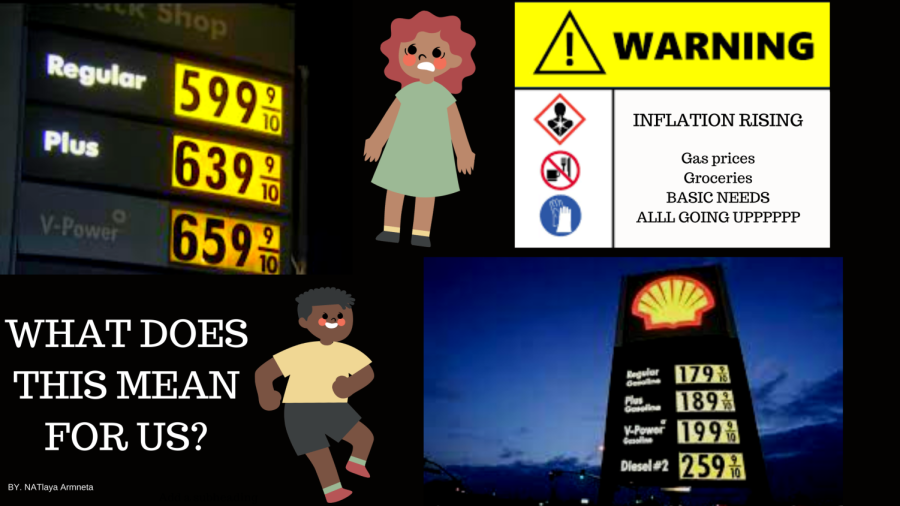Is inflation affecting you?
What is inflation?
Inflation is a general increase and decrease in prices in the purchasing value of money. It has always been around, it has had its ups and downs in the 19th century but finally settled down for about 40 years. Now it is back again and slowly starting to rise.
According to Trading Economics, inflation shot up by 7 percent last December. This was its first fast-moving incline since June of 1982. During the Covid-19 outbreak, people were subjected to quarantine and were restricted from going out at certain times and places. A change in routine due to influencers, and the overall discovery caused more demand for products. An article by Forbes states the highest increase over the past 12 months due to inflation; “Meat poultry, fish and eggs increased 12.5%, Fruits and vegetables increased 5%, Electricity increased 6.3%, Furniture and bedding increased 13.8%.” Those were just an overall increase over the past year but of course, it can vary from county to county, state to state, and even services located down the street from you.
Jobs were lost during the pandemic, forcing businesses to close down because of labor shortages and were more in debt by the government due to the multiple stimulus checks and other expenses that had to be covered.
Through the job losses and the adjustment of this new pandemic lifestyle, a spike in job opportunities came back and is evening out throughout the country.
Although inflation is affecting consumers, what about the suppliers or the people buying from their suppliers? When there is high demand for something limited they have to find a way to slow it down or produce more. Either way, it causes inflation in their product and once it’s marked up from the supplier it goes down the chain until it hits you.
The Food Market
Just like cars and houses, grocery prices are slowly increasing at your nearest Walmart, Target, or grocery store. According to Kimberly Clark, they have already raised prices for North Americans so, how many businesses have already raised their prices without notifying the public?
The New York Post points out, “The percentage increase in produce prices from November to December (of 2021), according to the U.S. The Bureau of Labor Statistics was twice that of other food categories.”
The article states that during the pandemic, there were higher demands for fresh fruits or ‘superfoods’. Having the time to discover self-love and healthy habits during the pandemic has caused a higher demand and with more shipments that may arrive late to your grocery store, prices rise. With high demand for fruits or vegetables, it is hard to keep the same prices due to shipment and fertilizer costs. Farmers aren’t able to grow a fully ripe avocado in a matter of 2 days. It takes more time, which is also why they are being charged more.
How are small businesses affected?
A study from business.org found that “82% of small businesses needed to increase their prices for products or services in response to high levels of inflation. Specifically, about 11% of small businesses reported having to raise prices by 10%, nearly half (44%) had to enact a 15% increase and 45% of small businesses said they raised prices by 20%.” This shows that small businesses are the working machines in America.
They are not only subjected to low-income areas but all over America. It allows for people to invent or produce products better than before and profit from them as well. Inflation is leading small businesses to upscale their prices which could create a loss for business too. Who would want to buy from a small business that sells products higher than before?
Tips for small businesses
When having a small business, you consistently have to check what the new trend is and see how you can promote your business to grab attention to your service or product.
Having up-to-date technology can make your business more efficient. Using old technology and not having a wide variety of payment options to make your business run smoothly could set you up for failure. Do not be afraid to spend on something you need now or that can make your product or service better because the return will be greater. When raising your prices, make sure that you do it in a time or way that doesn’t cause huge speculation as to why they went up. When prices need to go up dramatically, you want to slowly scale up multiple products instead of just one. In this way, there will be extra profit to cover the one product that needs to be paid for.
Your donation will support the student journalists of Parkdale High School. Your contribution will allow us to cover our annual website hosting costs and publish some printed editions, as well.

This is Natalya Armenta, a Senior at Parkdale High School. She has been on staff for two years and became a Section Editor in her first year....








Gillian Weinberg • Mar 4, 2022 at 7:49 am
Hi Natalya
This is a great article!
Very informative!
And a topic I’m sure many students are not aware of!
-Ms. Weinberg